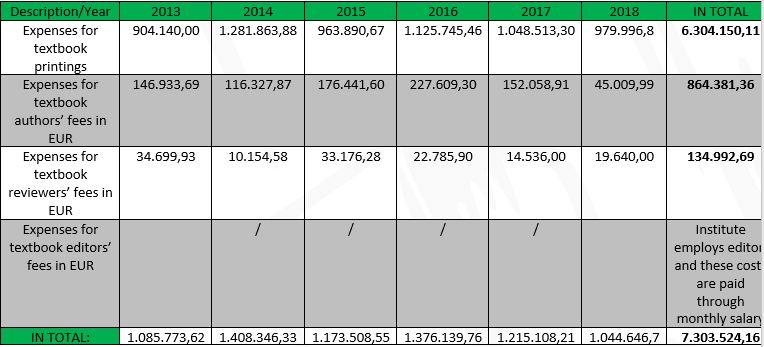Changes and additions to the textbooks each new school year have not led to qualitative improvement of formal education, they represent financial burden for parents, and the reform processes have been chronically unplanned, which affects the teaching staff, textbook deficiencies and huge costs, as it is concluded, amongst other, in the analysis of the Centre for Civic Education (CCE) ‘Why do pupil textbooks make headache?’
According to CCE data, the Government of Montenegro has allocated a minimum of 7,303 524.16 EUR for textbooks over the past six years. Of this amount, 6,304,150.11 EUR refers to the printing of textbooks, 864,381.36 for authors’ fees for textbook and 134,992.69 for reviewers’ fees. Expenditure for textbook editors should be added to this because the Institute for Textbooks and Teaching Aids has such workplace, and editorial expenses are paid through the monthly salary.
Since textbooks are being sold, those parents and several municipalities paying for textbooks, paid 4.632.160 EUR just for the elementary school sets for 2018/2019 (this is a figure based on the average cost of textbooks by the CCE team), which is significantly more than the annual cost of producing and printing these textbooks. To this should be added amount for high schools, where it is difficult to reach the indicative figure, besides for gymnasiums.
The textbook prices themselves do not change much. For the school 2018/2019 year, textbook sets, depending on the grade in the elementary school, were from 43.10 to 94.20 EUR, and for 2019/2020 from 39.80 to 94.20 EUR. In gymnasiums, these prices range from 59 to 106.80 EUR for 2018/2019, or 50.50 to 106.80 EUR for 2019/2020. Prices of textbook sets for secondary vocational schools are unavailable, as these vary depending on the school and department. For the purposes of the analysis, the CCE team took the second year of Law Department of the Secondary Economics School as an example and came up with a figure of 110 EUR for a set of textbooks.
Non-transparency in certain segments of the work of the Institute for Textbooks and Teaching Aids is also concerning. The CCE did not receive the list of all paid authors and reviewers, with the explanation that Institute does not have such lists for the period before 2018. However, the data for 2018 indicate that number of persons participating in the drafting of curriculum appear as textbooks’ reviewers in various fields, and in some cases up to 12 times. There is neither fixed fee for authors, as this varies considerably, nor exact number of authors hired per textbook. Also, there are no published public calls for obtaining authors’ manuscripts for the period before 2018.
Printing house ‘OBOD’ Cetinje has been the leader in the amount and volume of allocated funds for the last six years in the amount of 1,506,757.71 EUR, and is the only one that has been continuously printing textbooks for years, while other suppliers print smaller volumes and with less allocated resources.
Mistakes and oversights were noted in printed textbooks, but also that there was no revision of the printed copies. It is not even known that anyone was found responsible for this.
The CCE also made number of recommendations, pointing to these problems.
First of all, the Ministry of Education needs to make an assessment of how much money is annually needed for provision of free textbooks for primary schools, and the Government of Montenegro, in cooperation with the municipalities, should provide free textbooks for all pupils of primary schools. In this way, the constitutional provision on compulsory and free elementary education would be respected, that would contribute to equal status among pupils, but would also lead to more rational approach of the Bureau for Education Services, i.e. it would stop the textbook content changes for each new school year.
Also, in the five-year period, future options of plans and programmes should be strategically determined, in order to define textbooks for primary schools, and to avoid continuous changes to the content of the textbooks. That would also represent saving for Montenegro’s budget, and furthermore would allow ‘inheritance’ of textbooks.
The analysis also states that the procedures for selecting authors and reviewers should be regulated in order not to happen that one group of same people continuously writes and reviews textbooks, as this can lead to corruption. In particular, responsibility should be open for all authors found to have plagiarized textbooks or syllabuses and exclude them from any further engagements.
Moreover, the Bureau for Education Services must determine from teachers of secondary education institutions list of missing literature and textbooks for secondary vocational education and hire authors to produce missing textbooks.
Printing houses that make mistakes and oversights in printing textbook materials, i.e. textbooks must bear the responsibility for the mistakes made and compensate for the damage, as well as those who coordinate the process in the competent institutions.
The CCE believes that the Institute for Textbooks and Teaching Aids should provide for the school library fund with sufficient number of printed editions of textbooks for vocational courses in secondary schools, namely those textbooks that are in PDF format on the its website. In this manner, the same number of textbooks would be rented each year to new generations, with the obligation to return the textbooks at the end of the school year, similar to the Slovenian model.
Finally, in order to make the process transparent, the CCE assesses that textbooks funds (prints, authors, reviewers, etc.) should be published annually on the Institute’s website with precise amounts and names of the companies, i.e. authors and reviewers paid, with an indication of the purpose and any accompanying payments related to textbook production.
Vasilije Radulović, Programme Assistant

